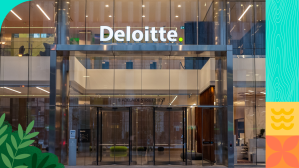New sustainability best practices help technologists cut emissions associated with IT, including heavy computational tasks
New Salesforce research shows that 75% of technologists want to develop software applications that do less harm to the environment
Today at World Tour NYC, Salesforce launched ‘Green Code,’ a new initiative to help reduce carbon emissions associated with the software development lifecycle. Green Code features newly-released sustainability best practices that help technologists — from UX designers and software developers to system architects and IT operations managers — accelerate the world’s journey to net zero.
The information and communication technology sector is responsible for up to 3.9% of global emissions — almost as much as the airline and shipping industries. These emissions are expected to rise as organizations increasingly rely on software to drive their operations and accelerate their digital transformation.
Fortunately, small changes can translate into big impacts for a company’s carbon footprint — and its bottom line. For example, Salesforce’s MuleSoft reduced its yearly public cloud infrastructure spending by 14% by optimizing strategies such as identifying and decommissioning underutilized systems and migrating storage to more energy-efficient alternatives.
“Sustainable engineering is good engineering and technologists can play a critical role in the reduction of global carbon emissions,” said Srinivas Tallapragada, President and Chief Engineering Officer at Salesforce. “With Green Code, we’re hoping to inspire software teams and the entire IT sector to prioritize sustainability, just as they do performance, security, and accessibility.”
Sustainable engineering is good engineering and technologists can play a critical role in the reduction of global carbon emissions
Srinivas Tallapragada, President and Chief Engineering Officer at Salesforce
“We’re in a climate emergency, and we need everyone to get to net zero as fast as possible,” said Suzanne DiBianca, EVP and Chief Impact Officer at Salesforce. “By leveraging these ‘green code’ best practices, technologists and organizations can approach the challenge of sustainability in IT to drive meaningful efficiencies and cost savings across their IT enterprises while accelerating their sustainability journeys.”
New guide enables technologists to take action on climate
According to new Salesforce research, 75% of technologists want to develop software applications that do less harm to the environment, but nearly half don’t know how.
Sustainability efforts to date have been largely focused on hardware efficiency and electric grid decarbonization. Optimizing the code that comprises these applications is a powerful leverage point that remains largely untapped.
The Sustainability Guide for Salesforce Technology offers practical recommendations for designing apps and writing code that have less of an impact on the environment. It focuses on four key areas.
- Design & UX: Designers can reduce energy use while providing a better user experience by making sustainability a design requirement and building a faster experience with fewer steps in data flow.
- Architecture: Choosing the right architectural pattern and deployment model for software development can lead to cost savings and reduce environmental impact. Software architects have a significant role to play in achieving this by integrating reusable APIs, enabled by MuleSoft, and preventing runaway code through governor limits built into the Lightning Platform.
- Development: Sustainable code is key. Developing software code that uses less energy can lead to significant emissions reductions, particularly when deployed at scale. Salesforce Lightning apps are coded to run natively in browsers, resulting in up to 60% improvement in performance and a reduction in energy use.
- Operations: By locating capacity in the right regions and scheduling workloads during high renewable energy periods, companies can reduce their carbon emissions. Salesforce is focusing on decarbonization efforts through innovations like Hyperforce, its public cloud infrastructure architecture built on 100% renewable energy, which will offer sustainability and functionality benefits to its customers.
“At L’Oréal, we’ve embedded sustainability throughout our business and products, and technology has always played a key role to help us achieve those goals,” said Ariane Thomas, Global Tech Director of Sustainability at L’Oréal Group. “I’m thrilled that Salesforce is launching best practices for technologists to reduce the environmental footprint associated with software development. Every company can benefit by implementing these changes and accelerate their sustainable achievements.”
Every company can benefit by implementing these changes and accelerate their sustainable achievements.
Ariane Thomas, Global Tech Director of Sustainability at L’Oréal Group
Green code is key to Salesforce’s IT decarbonization
Salesforce has made efforts to support sustainable IT practices. Most of the company’s carbon footprint comes from data center infrastructure, and reducing these emissions is a key pillar of its Climate Action Plan.
To track progress, Salesforce created a metric called Carbon to Serve, which measures the emissions of its data centers relative to work performed by its applications. Since establishing the metric in 2020, Salesforce has achieved a 26% reduction and aims to continue reducing emissions in the future.
More information:
- Check out the Best Practices for Sustainable Design module on Trailhead
- Learn 4 ways you can practice sustainable web design
- Read Salesforce’s Decarbonizing IT Infrastructure white paper
- Read the Salesforce research shows that 71% of IT leaders agree generative AI would increase their company’s carbon footprint through increased IT energy use















